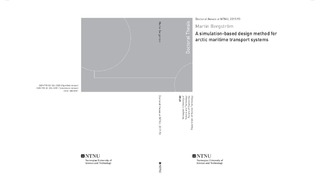| dc.contributor.advisor | Erikstad, Stein Ove | |
| dc.contributor.advisor | Ehlers, Sören | |
| dc.contributor.author | Bergström, Martin | |
| dc.date.accessioned | 2017-04-21T07:24:15Z | |
| dc.date.available | 2017-04-21T07:24:15Z | |
| dc.date.issued | 2017 | |
| dc.identifier.isbn | 978-82-326-2259-7 | |
| dc.identifier.issn | 1503-8181 | |
| dc.identifier.uri | http://hdl.handle.net/11250/2440209 | |
| dc.description.abstract | This thesis proposes a method for the conceptual design of arctic maritime transport solutions integrating the goal/risk-based regulatory system of the recently enforced International Code for Ships Operating in Polar Waters (Polar Code) into a holistic design process considering operational and regulatory requirements, cost-efficiency, and design robustness. To enable full utilization of the goal/risk-based regulations of the Polar Code, the proposed method makes use of system thinking and discrete event simulation (DES) based Monte Carlo simulations. As demonstrated through a set of case studies, system thinking enables a holistic design process by making it possible to treat an arctic ship as a part of a wider arctic maritime transport system (AMTS) including for instance icebreakers, and facilitates the design process by making it possible to divide an AMTS into a set of subsystems that can be designed separately. DES-based Monte Carlo simulations, in turn, makes it possible to assess the operational performance of an AMTS considering a multitude of stochastic factors and various interaction and self-reinforcing effects, and to determine operational data relevant both for the design of various ship systems, and for the assessment of the cost-efficiency and robustness of competing AMTS designs. To enable a time and resource efficient design process, the study analyses the level of model fidelity that is required to capture relevant behaviours of an AMTS. Also, sensitivity analyses are carried out to gain understanding of potential design uncertainties and how they can be mitigated. The method is limited to parametric design, i.e., to the determination of a set of design variables representing criteria to be considered for instance in the design of the hull shape, hull structure, and propulsion system. | nb_NO |
| dc.language.iso | eng | nb_NO |
| dc.publisher | NTNU | nb_NO |
| dc.relation.ispartofseries | Doctoral theses at NTNU;2017:93 | |
| dc.relation.haspart | Paper 1:
Bergström, Martin Vilhelm; Erikstad, Stein Ove; Ehlers, Sören.
Assessment of the applicability of goal- and risk-based design on Arctic sea transport systems. Ocean Engineering 2016 ;Volum 128. s. 183-198
http://doi.org/10.1016/j.oceaneng.2016.10.040
The article is reprinted with kind permission from Elsevier, sciencedirect.com | |
| dc.relation.haspart | Paper 2:
Bergström, Martin Vilhelm; Erikstad, Stein Ove; Ehlers, Sören.
A simulation-based probabilistic design method for arctic sea transport systems. Journal of Marine Science and Application 2016 ;Volum 15.(4) s. 349-369
Is not included due to copyright available at http://dx.doi.org/10.1007/s11804-016-1379-1 | |
| dc.relation.haspart | Paper 3:
Bergström, Martin Vilhelm; Ehlers, Sören; Erikstad, Stein Ove.
An approach towards the design of robust arctic maritime transport systems. I: Maritime-Port Technology and Development. CRC Press 2014 ISBN 978-1-138-02726-8. s. 185-192
http://dx.doi.org/10.1201/b17517-23 | |
| dc.relation.haspart | Paper 4:
Bergström, M. Erikstad, S.O., & Ehlers, S., (2017). The influence of model fidelity and
uncertainties in the conceptual design of arctic maritime transport systems. Accepted for
publication in Ship Technology Research – Schiffstechnik. | |
| dc.title | A simulation-based design method for arctic maritime transport systems | nb_NO |
| dc.type | Doctoral thesis | nb_NO |

